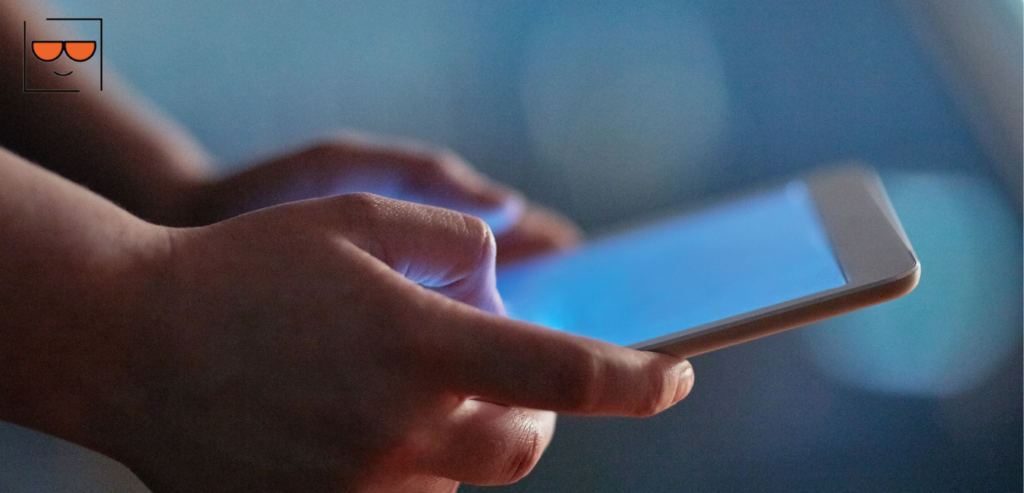
We have all heard too much blue light can be detrimental to our health. For example, spending long durations of time using digital devices can cause symptoms of digital eye strain, headaches, dry eyes, and even sleepless nights. As a result, several companies and products have promised to reduce blue light and its harmful effects through filters, glasses, and even desktop settings. But is night mode the same as blue blocking glasses?
This article will break down the difference between night mode and blue-blocking glasses to help you decide which option is best for you and your health.
What is Blue Light?
Blue light is everywhere, from natural sunlight to artificial light produced from screen-based devices. The visible light spectrum comprises red, orange, yellow, green, blue, indigo, and violet rays of light, which vary in wavelength and energy intensity. Blue light, however, happens to have one of the shortest wavelengths and the highest energy levels, which is why it’s referred to as High-Energy Visible light or HEV. Unfortunately, blue light is associated with several harmful effects on our health, including sleep issues, eye strain, and headaches.
The harmful effects of blue light, especially in the evening, have many concerned with reducing artificial blue light from screen devices. Two standard options for computers and smartphones are filters and night mode.
What is Night Mode?
Night mode is a setting featured on smartphones and computers to reduce the brightness and type of light emitted from your device. When turned on, the setting adjusts the display colors of your screen to warmer tones and reduces screen brightness to help with eye strain. According to your preferences, the setting features of night mode can be turned on and off manually or set to turn on automatically based on location.
While night mode is a readily available feature already programmed into your smartphone or computer, there has been no conclusive evidence to support that this feature does eliminate blue light. It is, however, a step in the right direction to protect your eyes.
What are Blue Blocking Glasses?

Amber-tinted sleeping glasses contain special lenses to eliminate harmful blue light from entering your cornea. These types of lenses successfully block out 99% of blue light emitted from digital devices while protecting your eyes from glare. It would be best if you used blue-blocking glasses about two hours before bed to increase melatonin production and keep your body regulated drastically. In addition, blue-blocking glasses are easy to wear and incorporate into your everyday routine.
What is the Difference?
In short, night mode and blue-blocking glasses are far from the same. Night mode is a great feature to use while on the computer or smartphone for digital eye strain. However, they do not have the same effect as blue-blocking glasses. Rather than actually filtering out the harmful blue light rays, night mode provides you with a yellow-tinted overlay and adjusts the brightness of your screen.
On the other hand, blue light glasses offer much more quality protection against blue light. The orange color used to make the lenses can filter 99% of blue light between the range between 400 nm to 530 nm. Furthermore, the purpose of blue-blocking glasses is to aid in sleep and digital eye strain, while comparatively, night mode on digital devices only protects against some digital eye strain. In addition, blue-blocking glasses have years of research to support their effects on blue light, while there has been no such study or investigation performed on night mode.
Should You Use Night Mode?
If you are wearing blue-blocking glasses, night mode is not necessary.
However, if blue-blocking glasses are not your disposable, night mode can be a good alternative. It is essential to note that night mode does not have the same effects as blue-blocking glasses and has not been proven to filter out blue light. Night mode is better than not using any eye protection when using digital devices, but it cannot protect the eye from harmful blue light.
For this reason, we highly recommend wearing blue-blocking glasses vs. night mode.
Wrapping Up
Blue light does contribute to digital eye strain and sleep issues. Since the blue light scatters easier than other types of visible light, it can’t be easily focused. As a result, when you are staring at digital devices, you are unfocused, contributing to the digital eye strain. While night mode can help reduce only some eye strain, blue-blocking glass can help eliminate blue light entirely. Increase your comfort when looking at your favorite device by trying blue light blocking sleep glasses today. If you wear regular prescription glasses also check out our fit over blue light-blocking glasses for at night before going to sleep. For night time you can use an amber night light so that you can wake up at night and still not be exposed to blue light while getting up to use the restroom.
Ready to try Blue Light Blocking Glasses?
Start Blocking Blue Light Today!
